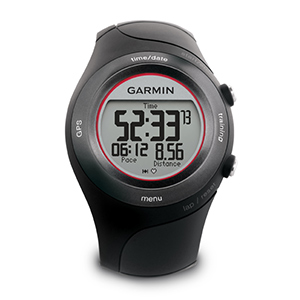Chances are, most runners have probably heard of Garmin. Garmin’s watches are a standard piece of gear for many runners, both amateur and professional. The reviewed below is on the Forerunner 410, an integral part of Garmin’s well-known line of GPS running/biking watches.
The most important aspect of running gear is its functionality. So, how does the 410 stack up? Satellite locking usually takes anywhere from five to fifteen seconds depending on location and records each mile accurately to within about +/- 0.01 mile. As marketed, the battery enjoys a decently long life and charges quickly, however, it gives little warning before going dead, meaning that users need to keep track of the battery level to avoid losing power during a workout. The outside casing is durable and water resistant enough to survive the mid-thunderstorm run that it was tested in. Functionally, the Forerunner 410 does essentially what it is supposed to do: accurately record time and distance during workouts. But of course, as a product of the technological age, this watch possesses quite a few comfort features for the classy runner. Several functions in particular are noteworthy from the first mile to the last.
The heart-rate monitor is a tool that is both useful and practical for runners of all levels. Made of stretchy but curiously comfortable fabric, the chest strap seldom slips and is hardly noticeable to the wearer. Wireless communication between the heart rate monitor and the watch is excellent, despite being bundled beneath layers of clothing or soaked with sweat. Data collected by the monitor is accurate and immediately factored into custom workouts.
The bezel-swipe function is one that has the potential to inspire either love or hate in its users. Although it allows for scrolling and reduces the number of buttons that can be broken, the touch bezel experiences variable sensitivity based on factors such as weather conditions and the temperature of the user’s hands, leaving runners with cold hands and warm hearts out of luck. The raised profile of the bezel can be cumbersome at times, and seems to attract accidental bumps. That being said, the watch is tough enough to survive a few hard knocks without signs of wear and tear.
One of the most touted features of the 410 is the ability to design custom workouts. Runners have the ability to create simple, interval, and heart rate workouts tailored to the individual. These workouts can be based on variables such as time, distance, calories burned, and target heart rate zones, and have the option of added features such as cool-down laps and a Virtual Partner. The only downside to Garmin’s solution for workout customization is the relative difficulty of changing a workout mid-run. With the 410, those wanting to create intricate runs must design and program workouts ahead of time, and be prepared to stick to the planned program throughout the run.
Last but not least, is the wireless connectivity between the Forerunner 410 and the user’s computer. Although this feature sounds great on paper, in practice connectivity can be limited. After extensive troubleshooting and internet searching, the Garmin ANT software was still unable to connect to the Windows 7 PC on which it was tested. Additionally, the Agent is set to automatically and somewhat annoyingly pop up upon start-up, and is tedious to disable.
Today, about two years since the 410 was first introduced into the market, this watch still holds up to buyer scrutiny and costs about half the price of Garmin’s newest Forerunners. The 410 is designed to help runners plan workouts and meet goals, and seems intended to strike a balance between computing capabilities and user-friendliness. Overall, the Garmin Forerunner 410 receives a thumbs-up for performance and practicality. It is capable of the more complicated workouts that serious runners need, but possesses the user-friendliness that rookies desire. Although not without its flaws, this watch is excellent for the price and would be an asset to any runner’s gear.


'Gear Review: Garmin Forerunner 410' has no comments
Be the first to comment this post!